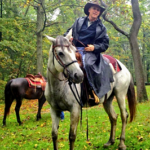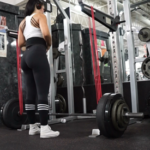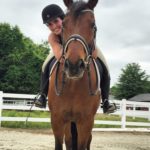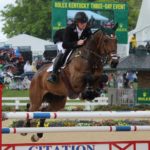“You’ve got a nice horse there,” said the new trainer at my barn. “He has great energy!”
“Yes,” I said. “He’s an amazing horse. Can you believe he’s 25?”
“No!”
That got me thinking. Advancing in age is not generally honored or valued in our society and this attitude carries over to our perception of the older horse. In this article, I hope to dispel the notion that the older horse should be automatically retired or overlooked as a suitable candidate for purchase. Older horses can be rewarding to ride, care for and share one’s life with. They are frequently sounder, wiser, more ready to work and teach and are exceedingly generous. Ironically, some have more to offer the ambitious rider precisely because they can be stiffer and consequently more difficult to ride well.
I spoke with four riders and owners of horses over 20 years of age, whose experiences and observations complemented my own. Each of these horse-and-rider combinations exemplifies a different aspect of what can be gained mutually when a senior horse is challenged by appropriate work while also being given plenty of time for play and relaxation.
My Journey with Brou
Brou is a Dutch Warmblood that I imported from Holland when he was 3. I was looking for a trained horse but fell in love with the green-broke dark bay with exceptional gaits and large, expressive eyes. It was, in many ways, a crazy purchase as I had no experience with untrained horses and Brou intimidated me almost as much as he attracted me.
It was not easy in the beginning. Brou was unruly, spooky and constantly testing my authority. I had to be firm, fair, set limits and pay close attention. I was determined to form a working partnership. So far, all 24 years that I have owned Brou have been wonderful, instructive, challenging years. He has rewarded my perseverance, consistency and care with affection, intelligence and thousands of days of great riding. Together we learned all the Grand Prix movements.
When he turned 20, I started becoming very attentive to his age, but at the same time I realized that our rides were becoming freer and more playful. When Brou was 23, he sustained a serious injury. I thought for sure that I would retire him but the rehab included riding and, to my surprise, he began going better than ever.
Brou, now 27, is not anyone’s preconceived idea of the older horse. He remains supple and fluid in his movement and has enough energy to spook and elude anyone who tries to bring him in too early from turnout. He is easily mistaken for a 10-year-old. However, the rhythms of our rides have changed. I have no set agenda. We no longer drill and push through the way we used to when he was moving up through the levels. Yet Brou continues to improve in self-carriage and periodically surprises me with the best passage or the best line of tempi changes he has ever done!
These older years have proved to be our most harmonious. I believe that Brou is finally satisfied that I have risen to the level of the competent and trustworthy owner he needs. He no longer tests me constantly, and I no longer need to make him listen to me. He is content and at peace with his place in the world. It is said that relaxation is crucial to achieve one’s potential in dressage, and perhaps we both needed to age to accomplish that.
Georgiann North and Kitt Kat
Kitt’s previous owner wanted to jump, and Kitt wanted to jump and also buck, so he was for sale. Georgiann North was not an advanced or particularly brave rider, but when she tried Kitt, she felt comfortable on him. In her first years with him, she showed him at First and Second Level. She won high score at one of the shows, but then her luck began to change. Kitt suffered a number of mysterious lamenesses that went on for seven years. No one could understand or diagnose the problem. Adaptive shoeing and various joint injections were not the solution. Georgiann continued to ride, but she was always concerned about Kitt’s welfare and was unable to profit fully from her lessons. Suddenly at 18, after his coffin joints were injected and his stall door closed so he couldn’t paw on the doorjamb all day, Kitt became sound and stayed sound.
Now in consistent work, Kitt at 21 looks fitter than ever with a strong topline and increasingly powerful, freer gaits. Georgiann and Kitt began showing again and have made steady progress. Her 8-year-old made his remarkable comeback at 20!
Georgiann says that she can relate to an older horse because “I am also an older creature.” The fact that they were both older motivated Georgiann to work harder. “It was our last chance to get better,” she says.
Nancy Pine and Rayson
Nancy Pine told her young horse, Zodi, “You are the best horse in the world—except for Rayson.”
Rayson is the 24-year-old Danish Warmblood whom she’s had since he was 4. “I appreciate Rayson more than I can say because he is the perfect teacher for me. He is saintly patient with an incredible work ethic as well as a formidable stubborn streak that matches my own.”
Nancy did not appreciate all these attributes when, while grazing 5-year-old Rayson on a rainy day in 1996, she found herself lying face down in the grass with a severely injured arm. Rayson had been on stall rest after having a minor arthroscopic procedure, and although Nancy has no recollection of exactly what happened, she was knocked unconscious, presumably from a kick, and both bones in her lower arm were shattered.
Nancy could not imagine that this misfortune would lead to one of Rayson’s most valuable lessons. The physical injury healed quickly, and she was back in the saddle in no time. Although she was not afraid to ride, she quickly discovered that she had acquired a terrible fear of leading Rayson or any horse even short distances. This went on for well over a year, until Rayson was 6 and Nancy decided to deal with her phobia.
She started to lead Rayson again—“teeny-weeny bits at a time.” She built upon each success, ultimately leading to a little mound of confidence. After a couple of months she started feeling comfortable. As time passed she did not limit herself to hand-walking and grazing. Her curiosity and newfound confidence led her to explore all kinds of groundwork. Without a local trainer for work in-hand and long-lining, she taught herself.
Things were destined to come full circle. When Rayson was 15 he got caught in the fencing and suffered a very serious hind-leg suspensory injury. The prognosis: retirement. One day several months into his retirement, Rayson started trotting along the fence line to greet Nancy as she arrived at the barn and he looked almost sound. The next day she began working him from the ground and gradually on long lines. Nancy attributes his full rehabilitation to this groundwork. Eventually Nancy went back to riding him. When he was 20, Nancy lent him to a young rider who, after riding him for only two weeks, showed him very successfully at Fourth Level.
Rayson was never a particularly easy horse to ride. And at 24, he is stiffer, bouncier and still has his own ideas. But he is never boring, and Nancy continues to work at “solving the Rayson puzzle.” She believes that older horses can be more challenging, especially to supple and change old habits (old habits that Nancy freely admits she created). “There’s more to figure out and therefore more to learn, which is great.”
Nancy hopes to keep riding Rayson in one way or another until the day he dies. Meanwhile Rayson continues to march briskly and decisively into the ring, ready to teach another day. He is currently much friendlier and trusting with people and enjoys lengthy turnouts. Rayson’s lessons have been a great benefit to Nancy’s younger horse, Zodiaco, whom she has trained to Prix St. Georges and Intermediaire I. And what Rayson taught Nancy has paid off for all of us. Nancy has become our in-house on-the-ground expert.
Heather Ward and Frenchie
Frenchie always liked to jump. Now that he’s 22, he still likes to jump. “Only the jumps are getting smaller,” says Heather Ward, head trainer at HW Dressage in Bedford, New York. Heather purchased Frenchie when he was 5. Later, when she became passionate about dressage, she leased him for a few years to someone who wanted to jump. Frenchie adapted well to his new riders. At 22 his basic characteristics remain unchanged: He continues to be the bombproof, uncomplicated teacher that anyone can ride but with varied results.
Like Rayson, Frenchie is not the easiest horse to ride well, but he does not overthink the task at hand and simply applies himself to what is being asked of him, mirroring the skill of his rider. If an advanced rider like Heather is aboard, his rhythm and frame are cadenced and harmonious. With a beginner, he reflects her lack of balance, but he never takes advantage or is dangerous. This makes Frenchie an excellent teacher and explains why he is earning his keep.
What has changed over the years is Frenchie’s health—and for the better. When he was younger, for many successive years he suffered repeated colic episodes. At 13, he underwent colic surgery and has been colic-free since.
In recent years he has had a few minor injuries but went through the healing process with the same equanimity and acceptance that he generally shows. And once healed, he was back out teaching and jumping enthusiastically. This past summer, a young woman leased him and showed at Training Level.
“I equate my old horse,” Heather says, “to that favorite pair of comfy blue jeans that you’ve had forever. They’ve worn a bit thin, but they’re super soft and fit perfectly. Sometimes they get a hole, and you patch it up, and you keep wearing them and keep going. They’re just the perfect fit.”
Denise Avolio and Molly
A jumper rider spotted a nameless, small brown mare standing alone in a field in Belgium and decided to buy her over the fancier-looking horses she was being shown. She made an intuitive choice she would not regret. The mare she eventually named Molly proved to be a feisty, talented and generous jumper, earning the nickname “the little engine that could.” She jumped the 4’6” courses and excelled at the 4’3” ones. She jumped picnic tables for fun and brought pleasure to her several owners.
At 18, she met Denise Avolio’s 13-year-old daughter, Dana, who wanted to start show jumping. Dana and Molly showed successfully at 2’ and 2’6” until, at 21, Molly injured her check ligament.
As Molly’s ligament was mending, Denise, a certified therapeutic riding instructor, saw another opportunity for Molly to continue her career by giving adaptive riding lessons to disabled children. As Molly is sensitive, comfortable and loves being groomed, Denise thought she would be the ideal horse for both on-the-ground and riding lessons.
Last spring, at the age of 23, Molly’s career took a new turn when Rebecca Helman, a visually impaired hunter-jumper rider, approached Denise to learn about dressage and Para-Dressage. Denise began teaching Rebecca to navigate the dressage arena on Molly. Both Molly and Rebecca showed impressive courage and mutual trust, especially evident when they made mistakes and ended up weaving calmly in and out of the arena’s boundaries. As a teacher Molly not only earns 90 percent of her keep, but also continues to be ridden and worked intermittently by Denise and Dana.
Like the other owners, myself included, Denise wishes to keep Molly, now 24, working as long as possible because she loves her work. “Older horses are not so complicated,” she says. “They just need good food, good turnout and appropriate work.”
Worth the Risk
It is impossible to deny the bittersweet aspect of owning and riding an older horse—the expectation that at some imminent point the relationship must change or end.
However, for the owners I spoke with, the benefits far outweigh the disadvantages. These senior citizens have bred loyalty and love in their owners who want and intend to enjoy and stand by them throughout their mature years.
Yet older horses remain generally undervalued. So if you are looking for a horse to ride or purchase, consider the older horse. You may discover a great partner, teacher and even competitor, and above all, you may be in for a lot of fun!
Eva Colacicco, PhD, started riding dressage in Switzerland in the 1970s. She competed Brou as an amateur through Intermediaire I and trained him to Grand Prix. She says she has learned much from excellent teachers, but has learned the most from Brou.
Dressage and Longevity
By Beth Baumert
It’s interesting that the photo shoot of these senior horses and their skilled riders yielded far more usable photos than the average dressage photo shoot. Some of the senior horses in this story still look like 10-year-olds, and some are low-maintenance horses. The primary reason for their superior longevity and spry bodies is that they are back movers—not leg movers. That is, they are ridden through the back to the bit. Good horse-and-rider balance is key. Here’s how these riders do it:
The Well-Balanced Rider. The ideal rider of a senior horse has a well-balanced position, so her weight is carried around the horse, not on top of him. This enables him to lift his back. Some aged horses have difficulty carrying too much weight so they often do better with riders who aren’t overweight.
The Well-Balanced Horse. Horses hate to be out of balance and can actually be disagreeable with riders who don’t know how to set them up so they use their backs. Riders need to be aware that the topline must keep working. As soon as the horse’s back starts to sag, he becomes a leg mover. Comfort and soundness suffer. This is a special incentive for the riders of senior horses to understand the following about helping their horses be back movers:
• Longitudinal balance. The hindquarters need to produce enough rhythmic energy to go through the back and reach the bit. You don’t do the senior horse a favor by letting him piddle around in a flat or hollow frame. The rider’s driving leg aids and regulating seat encourage him to step up to the bridle without getting fast. It is frequently a challenge to prevent the eager senior from running. Speed control is key. Low, quiet hands in half halts say, “Wait for me!” to prevent the horse’s cheerful enthusiasm from taking over. Part of the warm-up process is always upward transitions to send the energy to the bit and downward transitions to remind the horse to come back, engage his hindquarters and close his frame in half halts from weight and light rein aids.
• Lateral balance. The horse’s neck ideally falls down from the withers. Slight inner rein aids flex him a bit to the inside, and the inside leg puts the horse to the outside rein. The rider controls the horse’s inside hind leg by asking it to step between the prints of the front feet. He controls the outside hind leg by asking it to step in the print of the outside fore. That’s shoulder-fore. When you can do shoulder-fore equally well in both directions, the horse is straight and can balance on the outside rein. When the connection is correct, all movements improve the throughness, the connection and harmony.
Ideally, the senior horse isn’t out of work for long periods of time. He might be worked three to six days per week for 45-minute sessions, including lots of walk. He might work hard at times, but he should never be too tired at the end of a session.
Dressage Today Technical Editor Beth Baumert is the author of When Two Spines Align: Dressage Dynamics.








